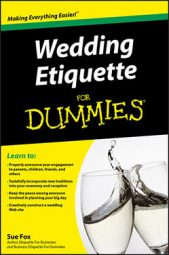Different types of wedding ceremonies and receptions have different levels of formality; black tie, formal, semiformal and informal are the terms used to dictate the level of formality in guests’ attire.
What you, your spouse-to-be and your wedding party wear also hinges on your wedding’s overall level of formality, which should be indicated in your invitation. If you and your partner are usually on the casual side, having a black tie wedding may not be comfortable or fitting for you. On the flip side, this is one time in your life when you may want to splurge and crank up the formality a bit. Be sure to select elements of your wedding within the same level of formality so that your entire day will flow with ease and style.
Black tie
Traditionally, black tie attire marks a very formal event — one that takes place in a house of worship or an upscale hotel, has an elaborate sit-down dinner at the reception and features at least 200 guests and a large wedding party. Black tie weddings don’t have to be in the evening. Your wedding can begin in the late afternoon ad still be very formal.
Brides and bridesmaids wear elegant, full-length gowns (with train and veil for the bride), and grooms and groomsmen wear black tailcoats and pants, white stiff shirts and white ascot ties and black socks and shoes.
Formal
A formal wedding is typically held in a house of worship or hotel, starts in the afternoon or evening, has a sit-down dinner or buffet at the reception and features at least 100 guests. The bride and groom each traditionally have between three and six attendants.
The bride at a formal wedding wears a full-length gown with a sweep or chapel train, and a fingertip veil. Grooms and groomsmen wear tuxedos: black coats, black pants, white shirts, black vests and black ties. Bridesmaids match in full-length dresses.
Semiformal
A semiformal wedding can be held in a house of worship, but you can also have one in a home, an outdoor location or another spot. It traditionally starts in the afternoon, has a simple meal or refreshments at the reception and features fewer than 100 guests. The bride and groom each have between one and three attendants.
The bride wears a full- or cocktail-length gown with a short train or no train at all and a fingertip veil. The groom and groomsmen wear matching tuxedos or dark suits, and bridesmaids wear matching full- or cocktail-length gowns.
Informal
An informal wedding is usually held during the day in a home or another spot that isn’t a house of worship. It has a simple meal or refreshments at the reception and features fewer than 50 guests. The bride and groom typically have only one attendant.
Informal brides may wear a knee- or cocktail-length wedding dress with no veil or anything from a pantsuit to a linen sundress. The men might wear suits and ties or shorts and flip-flops, depending on the occasion.
For informal weddings, you don’t need to add any notation to the invitation. Only black tie and formal weddings need to be indicated.

